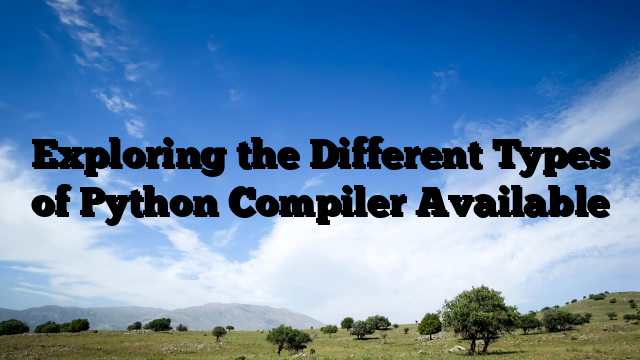- Exploring the Amazing Python Features
- Understanding Memory Management in Python: A Comprehensive Guide
- Exploring the Benefits of Python Programming
- Exploring the Best IDE for Python Programming
- Java or Python: Which Language Holds the Key to Your Programming Success?
- PHP vs Python: Which Language is Best for Your Project?
- From Bugs to Brilliance: Harnessing Python Exceptions for Powerful Coding
- Types of inheritance in python
- How to Create an Android App with Python
- Python vs C++: Uncovering the Best Programming Language for Your Needs
- How should I start learning Python?
- Python Dictionary: A Comprehensive Guide to Understanding and Using Dictionaries
- Introduction to Python Generators: What They Are and How to Use Them
- A Comprehensive Guide to Understanding Python else if Statements for Optimal Decision Making
- Boost Your Programming Skills with Python NumPy: An In-Depth Exploration of Its Features
- Exploring the Different Types of Python Compiler Available
- Understanding Python Tuples: A Comprehensive Guide
- Python List: A Comprehensive Guide to Working with Lists in Python
- Exploring Logical Operators in Python: A Comprehensive Guide
- Exploring the Different Types of Python Operators: A Comprehensive Guide
- A Comprehensive Guide to Python Datatypes
- Introduction to Python for Beginners
- Python Download: Your Comprehensive Guide to Getting Started
- how to comment out multiple lines in python
This article provides an introduction to Python for beginners. Python a powerful, high-level, object-oriented programming language that is widely used in web development, software engineering, data science, and other fields. It is easy to learn and provides a great platform for developing applications quickly and efficiently. This article will provide an overview of the language, its features, and the advantages of using Python. It will also provide resources for further learning and practice. With this knowledge, beginners can get started with Python and start building their own applications.
Overview of Python and its Features
Python for beginners is a popular programming language that is used for a wide variety of tasks, from web development to data science. Python is a general-purpose, high-level programming language that is designed to be easy to read and understand. It is often used as a scripting language, but it can also be used to create powerful applications.
Python is an interpreted language, meaning that code written in Python is not compiled before it is run. This makes it easier to develop and debug code, as well as making it easier to port code from one platform to another. Python is also a dynamically typed language, meaning that the type of a variable is determined at runtime, rather than when the code is written.
Python is an object-oriented language, meaning that it is designed to work with objects and classes. This makes it easier to write code that is more maintainable and reusable. Python also has a wide range of built-in features, such as a standard library, an interactive interpreter, and an extensive collection of third-party libraries.
Python is also known for its readability and ease of use. It has a simple syntax that is easy to learn, and it is designed to be intuitive and straightforward. This makes it an ideal language for beginners. Python also has a large community of users and developers, making it easy to find help and resources when needed.
Python is a powerful and versatile language that can be used for a wide variety of tasks. It is easy to learn and use, and it has a wide range of features that make it a great choice for beginners. With its readability, ease of use, and extensive library of third-party libraries, Python is a great choice for anyone looking to get started with programming.
2 Installing and Configuring Python
Installing and Configuring Python beginners is a straightforward process. Python is a popular programming language that is widely used for scripting, automation, and data analysis. It is a powerful language that is easy to learn and can be used to develop applications for web, desktop, and mobile.
The first step in installing and configuring Python is to download the latest version of the language from the official Python website. The download page will provide a link to the latest version of Python, as well as instructions for installation. Once the download is complete, the user should follow the instructions to install Python on their system.
The next step is to configure Python for use. This includes setting up the environment variables, which will tell the system where to find the Python interpreter and other necessary components. Additionally, the user should install any additional libraries or packages that they may need for their project. This can be done using the pip command-line tool, which is included with the Python installation.
Once the environment is set up, the user can begin writing Python code. Python is an interpreted language, meaning that it is executed line-by-line as the code is written. This makes it easy for beginners to learn the language and start developing applications quickly.
Finally, the user should familiarize themselves with the Python standard library. This library contains a large collection of modules and functions that can be used to perform various tasks. It is important to understand the different modules and functions available in the library, as this will help the user write more efficient code.
Installing and configuring Python for beginners is a straightforward process. With the right tools and resources, anyone can get started with Python and start developing applications quickly.
Syntax and Basic Data Types
Python for Beginners can be a starting point for those who are just beginning to learn programming. Syntax and Basic Data Types are two of the most important concepts to understand when learning Python.
Syntax is the set of rules that dictate how a programming language is written. In Python, this includes the structure of the code, the use of indentation, and the use of keywords. Syntax is important because it ensures that the code is written in a way that is both readable and understood by the computer.
Basic Data Types are the building blocks of programming. They are the fundamental data structures that are used to store and manipulate data. In Python, there are several basic data types, including integers, floats, strings, booleans, and lists. Each of these data types has its own set of rules and functions that can be used to manipulate them.
Understanding Syntax and Basic Data Types is essential for anyone who wants to learn Python. By understanding the basics of these concepts, it will be easier to write code that is both efficient and readable.
Control Flow and Iteration
Control Flow and Iteration are two of the most important concepts in programming, and are essential for Python beginners to understand. Control Flow is the order in which the instructions of a program are executed. It is the ability of a program to make decisions and take different paths based on the conditions of the program. Iteration is the repetition of a set of instructions in a program. It is used to execute a set of instructions multiple times, and can be used to solve complex problems.
Control Flow is achieved through the use of conditional statements. These statements are used to determine whether a certain condition is true or false, and based on the result, the program will take a certain path. The most common conditional statements are if, else, and elif. The if statement is used to check if a certain condition is true. If it is, the program will execute the code inside the if statement. The else statement is used to execute code if the condition is false. The elif statement is used to check multiple conditions, and execute code based on the result.
Iteration is achieved through the use of loops. Loops are used to execute a set of instructions multiple times. The most common loop is the for loop. The for loop is used to iterate over a sequence of elements, such as a list or a string. It is also used to execute a set of instructions a certain number of times. The while loop is used to execute a set of instructions until a certain condition is met.
Control Flow and Iteration are essential concepts for Python beginners to understand. They are used to create complex programs and solve complex problems. With a good understanding of these concepts, Python beginners can create powerful programs.
Writing and Executing Python Programs
Python for Beginners is a great way to get started with coding. Python is a powerful, high-level programming language that is used for a wide variety of tasks, from web development to data science. Python is also a great language for beginners, as it is easy to learn and use.
Writing and executing Python programs is a straightforward process. First, you need to install a Python interpreter, such as the official Python software, on your computer. This will allow you to write and execute Python code.
Once you have the Python interpreter installed, you can start writing your program. Python programs are written in plain text files, and can be written using any text editor. It is important to save your program with the .py extension, as this tells the Python interpreter that the file contains Python code.
Once you have written your program, you can execute it by running the Python interpreter and passing it the name of your program file. The interpreter will then read the program and execute it, running the instructions you have written.
Python is a great language for beginners, as it is easy to learn and use. Writing and executing Python programs is a straightforward process, and can be a great way to get started with coding.
Python is a powerful and versatile programming language that is ideal beginners. It is easy to learn and provides a wide range of features that make it a great choice for developing applications. Python is also an open source language, meaning that it is free to use and can be modified to suit the needs of the user. With its wide range of features, Python is a great choice for anyone looking to get started with programming.



















